Clean Tech Leadership Index Ranks States and Cities
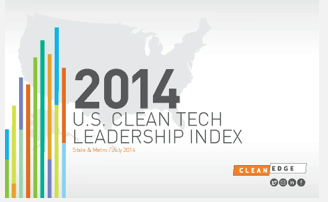

As we push towards a radical overhaul of the world economy, with the goal of establishing a sustainable human presence on the planet, it is important to manage our progress. As quality expert Edward Deming once said, “You can’t manage what you can’t measure.” It’s a good thing, then, that we have organizations like Clean Edge to provide extensive benchmarking services in the clean technology and sustainability area.
This week the organization released its 2014 Clean Tech Leadership Index. The report tracks clean technology progress in all 50 states, as well as the top 50 metropolitan areas in the U.S. The state index rates three subject areas: technology (in areas such as electricity, transportation and building), policy (regulations and incentives), and capital (including financial, as well as human and intellectual). Cities are ranked based on four categories: green buildings, advanced transportation, clean electricity and carbon management, and investment, innovation and work force.
The top 10 states are predominantly clustered near the coasts. They are, in order, shown with scores:
- California (93.7)
- Massachusetts (79.4)
- Oregon (67.0)
- Colorado (66.8)
- New York (64.8)
- New Mexico (61.9)
- Washington (61.6)
- Illinois (61.5)
- Vermont (58.6)
- Connecticut (57.3)
As you can see from the scores, California clearly dominates. This is backed up by the fact that five of the top 10 cities [rank] (San Francisco [1], San Jose [2], San Diego [3], Sacramento [5] and Los Angeles [7]) are found in the state. The remaining cities are Portland [4], Boston [6], Washington, D.C. [8], Austin [9] and Denver [10].
Takeaways from state rankings
A few state highlights are worth mentioning.
- Massachusetts scored second (and, along with California, is substantially ahead of the pack) despite ranking twelfth in the technology category. The state more than made up for this shortfall with strong showings in both policy and capital, ranking No. 1 in both.
- Vermont jumped six places to move from fifteenth to ninth, bolstered by venture capital deals, energy efficiency program dollars, and hybrid and electric vehicles.
- Connecticut cracked the top 10 for the first time this year, with help from its Clean Energy Investment and Finance Authority, strong regulations and mandates, and a large amount of fuel cell capacity and clean-tech patent activity.
- The bottom five states were Nebraska, North Dakota, Alaska, West Virginia and Mississippi.
In the technology category, the clean electricity ranking (as a fraction of total generation) was dominated by Midwestern states. None of the top six in this sub-category (Iowa, South Dakota, Kansas, Idaho, Minnesota and North Dakota) made the top 10 overall. The top two both produced more than 25 percent of their state’s electricity from wind.
This is particularly impressive considering the fact that some of these states have faced strong opposition to renewables. California actually had about the same amount of total solar generation as Iowa’s wind capacity (roughly 5200 MW), but it was a far smaller percentage of that state’s total generation. Texas did not make the list, despite having the most installed wind power in the nation. That’s because the state energy usage is so high that wind power as a percentage (11 percent) is not high enough to make the list. (Texas uses almost 50 percent more electricity than California despite its smaller population.)
California leads in both the number of hybrids and electric vehicle. Colorado has the most LEED-certified buildings per million people, followed by Vermont and Oregon.
The policy arena, which tracks clean-tech policies including mandates, regulations and incentives, is mostly dominated by East Coast states (Massachusetts, New York, New Jersey, Connecticut and Rhode Island). Minnesota, which was ranked tenth, is the only other state that wasn’t in the top 10 overall.
California has by far the largest capital investment ($2.25 billion), but because of its size was ranked second next to Massachusetts, on a per capita basis. Massachusetts spent $433 million which was the second highest overall amount.
Cities leading the charge
In the cities ranking, San Francisco once again dominated with a score of 94.4, outpacing its rival and neighbor San Jose by 14.7 points. SF took the top spot in all four categories.
Most improved this year were Pittsburgh, moving up 11 places to No. 28, and Atlanta, which moved up eight slots to No. 16. Detroit, surprisingly, moved up seven slots to No. 19, leapfrogging over both New York (23) and Philadelphia (21). That was due to its fourth place ranking in the area of Investment, Innovation and Work force. Drilling down further, this appears to be due to its number one ranking in the category of clean tech patents per million people. These were most likely due to patents pertaining to hybrid, electric and other advanced vehicle technologies.
The bottom line
This type of ranking system, despite being imperfect and sometimes heavily skewed by the criteria (and definitions used in developing that criteria, e.g. per capita basis) and weightings, can still be very useful to show overall trends and relative behaviors.
While this overview only scratches the surface, spending some time looking at a report like this can give a good overview of the current state of affairs in the very dynamic world of clean technology. For those state and municipal leaders looking to improve their standing in the clean tech world, this could be an excellent starting point. Looking at what other leaders have done in other parts of the country could be a source of inspiration and innovation.
Image credit: Clean Tech
RP Siegel, PE, is an author, inventor and consultant. He has written for numerous publications ranging from Huffington Post to Mechanical Engineering. He and Roger Saillant co-wrote the eco-thriller Vapor Trails. RP sees it as his mission to help articulate and clarify the problems and challenges confronting our planet at this time, as well as the steadily emerging list of proposed solutions. His uniquely combined engineering and humanities background help to bring both global perspective and analytical detail to bear on the questions at hand.
Follow RP Siegel on Twitter.
New Trend: Climate Optimists Say Climate Change Won’t Be So Bad


We all have that crazy uncle who shows up at family reunions, trying to convince us that climate change isn’t real and Barack Obama was born in Kenya. But maybe you also have a relative who tells you he welcomes climate change because he’s looking forward to the warmer weather in his chilly hometown.
Accepting that climate change is happening but putting a positive spin on the consequences is a growing view in the climate skeptic camp, Slate reports. And this new “climate optimism” was on full display at the last week’s ninth International Conference on Climate Change, billed as an “International Gathering of Scientists Skeptical of Man-Caused Global Warming.” Held ironically enough in drought-stricken Las Vegas, the event was organized by the Heartland Institute, which proudly proclaims that the Economist has called it “the world’s most prominent think tank supporting skepticism of man-made climate change.”
“I don’t think anybody in this room denies climate change,” James M. Taylor, senior fellow at the Heartland Institute, said in a speech at the conference, Slate reported. “We recognize it, but we’re looking more at the causes, and more importantly, the consequences.”
That’s right – the climate change debate is moving beyond denial and even a “discussion” of its sources to focus on its effects – and frankly, these climate skeptics say, it won’t be so bad.
Earlier this year, the Heartland Institute published a report, “Climate Change Reconsidered II,” which came to the conclusion that the benefits of changing climatic conditions “greatly exceed any plausible estimate of its costs.” The study was compiled by a group of scientists satirically calling themselves the Nongovernmental International Panel on Climate Change (NIPCC); the NIPCC says it is able to offer a “second opinion” to the United Nation’s Intergovernmental Panel on Climate Change, which, by the way, recently announced that climate change’s impacts are going to be worse than previously predicted.
Higher levels of carbon dioxide in the atmosphere will actually be advantageous to plants, the report says, in what sounds like a fourth grader’s scientific train of thought: Plants will grow faster, bear more fruit, and develop a greater resistance to drought and pests. Wildlife -- even the polar bears – will thrive as warmer temperatures broaden their habitat, according to the report, although the polar bears struggling to grasp to thawing ice in the “Planet Earth” documentary series might tell a different story. And coral bleaching caused by warmer oceans? No problem, the NIPCC says; coral has survived previous warming periods just fine.
The real threat to the planet, the report’s authors contend, is cutting back on our use of fossil fuels because we are concerned about climate change’s negative impacts.
“Dramatically reducing the use of fossil fuels would have devastating effects on workers and consumers of both the developed and developing worlds, leading to severe hardship and even deaths,” the Heartland Institute writes in a press release.
You heard them right: Don’t worry about the increased floods, drought, disease and famine caused by climate change – or the 150,000 extra deaths each year the World Health Organization predicts due to rising temperatures. Instead, we should fear the consequences of stronger regulations that lead to a healthy environment and a transition from a fossil-fuel-based, monopolistic economy to a growing green economy that relies on clean-burning renewables.
The NIPCC’s recommendations – rolling back environmental legislation, “responsible” development of fossil fuels and overall “free-market environmentalism” – truly reveal their and other climate skeptics’ beef with climate action advocacy. This isn’t a debate about the causes of climate change or how severe its effects will be; it’s an argument for maintaining business as usual, instead of dramatically changing how we live and work to keep our planet and ourselves healthy.
But an even more troubling question remains: With over 50 percent of Americans admitting they worry about climate change very little or not at all, will this new “climate optimism” put up another barrier to addressing climate change?
Image credit: Flickr/Sharon M Leon
Passionate about both writing and sustainability, Alexis Petru is freelance journalist based in the San Francisco Bay Area whose work has appeared on Earth911, Huffington Post and Patch.com. Prior to working as a writer, she coordinated environmental programs for Bay Area cities and counties. Connect with Alexis on Twitter at @alexispetru
Governor Christie Pulls New Jersey Out of Regional Greenhouse Gas Initiative
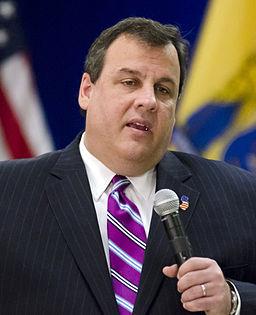

So this is what American politics have come to in 2014. New Jersey Gov. Chris Christie appears on NBC’s Meet the Press, then quietly jets out to Vail, Colorado to appear at an exclusive and secretive Koch Brothers strategy meeting. Not a word of this was spoken to his constituents back home. He spoke to an audience of some of the wealthiest people in the country, who have become considerably wealthier over the past decade, about how “America is careening into an economic crisis.” He boasted to the ultra-conservative crowd that “the governorship in New Jersey is the most powerful constitutional governorship in America." I take that to mean he has extraordinary executive powers to do his and their political bidding.
One step that he has just recently taken is to withdraw New Jersey from the Regional Greenhouse Gas Initiative (RGGI), something he has been threatening to do for several years. RGGI is a voluntary alliance between nine mid-Atlantic and New England States, which have agreed to work cooperatively to reduce carbon emissions through the use of emission credits that could be traded within the cooperative. RGGI states have reduced their emissions at a higher rate than their non-RGGI counterparts. The price of carbon credits has climbed to $4/ton, another sign that the program is working. If there is a problem with the system, it is that it hasn’t been aggressive enough in locking in reductions. Christie claimed, wrongly, that participation would make the state less competitive. Numerous studies and analyses have shown that sustainable enterprises do better, by reducing costs, avoiding penalties and attracting the best talent. The governor was praised for his move by David Koch, who described it as a “commitment to the free enterprise system.” This commitment to free enterprise apparently lapsed when Christie banned EV maker Tesla from selling its cars in the Garden State. Tesla’s direct-to-consumer marketing poses a threat to the politically-connected car dealer networks, long known for their campaign support, which hold a monopoly in the state. Such contradictions are nothing new for the governor, who said back in 2011, that “the future for New Jersey is in green energy.” Of course that was before he became involved with the Koch brothers and their extensive oil and gas interests. Since 2011, he has scaled back renewable energy goals and rebates for residential solar, as well as vetoing a bill that would have banned the disposal of fracking waste. A number of concerned individuals have tried to persuade the governor to reconsider his move.Congressman Frank Pallone of the 6th District was one of these. In an impassioned letter, he reminded the governor that “New Jerseyans know firsthand what the cost of climate change is. If we do not start taking the prospect of climate change seriously, devastating storms like Superstorm Sandy will become the new normal." We all remember the governor’s walk around with President Obama after the storm and his unrestrained praise for the president for coming to the state’s aid. Ken Kimmell, president of the Union of Concerned Scientists and the former chair of RGGI, also wrote to the governor, pointing out that not only has RGGI been effective in achieving its mission, but it has also led to the creation thousands of jobs (16,000 in its first three years, to be exact). Even more importantly, he told the governor, New Jersey will need RGGI to meet the new EPA emissions targets which aggressively seek a 43 percent reduction in CO2 relative to 2012 levels by 2030. Remaining in RGGI, he argued, would allow the state to pool resources with its neighbors. According to Analysis Group, the 10-state RGGI economy grew by $1.6 billion dollars while reducing emissions, and residents saved $1.3 billion in energy costs. Finally, a resolution being put forward by NJ State Senate President Stephen Sweeney and State Senator Bob Smith could force the governor to remain in the coalition. Their resolution is based on a recent court ruling that Christie broke the law when he used an executive order to pull out of RGGI, overruling a Democratic state legislature. The court ruled back in March that the state Department of Environmental Protection (DEP) must formally repeal the membership regulations before the state can withdraw from the program. To do this, the administration must seek public comment, which was not done. “Neither Gov. Christie nor the New Jersey Department of Environmental Protection can simply repeal state laws by fiat,” said Susan Kraham, senior staff attorney at Columbia University’s Environmental Law Clinic. Apparently those executive powers are not quite as extensive as the governor thought. The state legislature has tried twice before to pass a bill requiring the state to remain in RGGI. Christie vetoed both bills. But this latest resolution is supposedly veto-proof. If the move succeeds, the Koch brothers will be very disappointed, no doubt. I'm sure that they are hard at work, trying to keep that from happening at this very moment. Image credit: Bob Jagendorf: Wikimedia creative commonsEden Foods Endures Customer Backlash for Birth Control Stance


Until June 30 of this year, Hobby Lobby was best known for its arts and craft supplies and do-it-yourself home decor options. But on July 1, that all changed.
As a result of a Supreme Court decision that its owners – and those of other “closely held” companies – did not have to provide insurance coverage for birth control, Hobby Lobby was catapulted into the partisan spotlight. A name that was once synonymous with candle-making supplies is now the poster child for businesses that object to Affordable Care Act regulations on what a company must provide for its workers.
But it isn’t the only business fighting this battle. Hobby Lobby’s unexpected court win gained the most attention, but the ACA was actually being challenged by approximately 100 small, privately-owned businesses. These companies, largely because of religious views, took exception to the idea that the insurance they provide might make it easier for women to access birth control.
And what many have been surprised to hear is that one of the largest proponents of this view (and a litigant in a battle against ACA) is the owner of an organic foods label. He's well known for his sustainability outlooks and wholesome focus on principles that are often assumed go with, well, more liberal values.
But Michael Potter, owner of Eden Foods, makes no apology for the dichotomy between his objection to being required to pay for his workers’ birth control and his progressive stance on back-to-basics farm food.
He’s used flippant comparisons to get his point across (“I’ve got more interest in good quality long underwear than I have in birth control pills.”) and has no compunctions against railing to female journalists about issues that are normally between a patient and her doctor.
Still, now that Hobby Lobby has won its case, Potter may have another chance to make his point before a judge.
His suit, in response to the Obama administration’s denial of his right to refrain from paying for health insurance that included contraception coverage, was filed in March 2013 -- and subsequently turned down by the Court of Appeals.
Hobby Lobby’s win may now give him another crack at winning this argument. That would mean his company would hold a similar status to churches and other religious nonprofits, in that it would not be expected to pay for contraception for its employees.
But the question that remains now is: At what price? As Sarah Ventiera, writer for the Broward Beach New Times notes, demographics are often an important consideration in the food industry, and Potter, and his company Eden Foods, appear to have forgotten that progressive food concepts like organic, non-GMO products often garner support from consumers who are exceedingly progressive in other perspectives as well, like healthcare and birth control.
What’s surprising is that no one has raised the fact that birth control is often prescribed for medical reasons other than contraception, and that some women would be at risk if they became pregnant. Does this mean that religious values trump the value of a human life? And what does a woman – or an employee whose wife requires birth control – do if the employer has the right to exercise his or her religious values at work over the health concerns at home?
Eden Foods customers aren’t happy with the debate, either. The angry comments and threats of boycott that the company endured in 2013 have started reappearing on Eden’s Facebook page, accompanied now by tweets of selfies from disgruntled customers who say they intend to stop buying the company’s products. Some are also returning Eden products “until the company stops its attack on birth control.”
Potter may win this one in the courts, but it’s debatable whether his company will win from the loss of business.
Meanwhile, Senate Democrats have heard the call and are working quickly to pass a bill that could ensure women can still be covered for contraception. The bill might pass the Senate, but it has less likelihood of making it past House Republicans. Many, after all, answer to constituents with the same conservative values that the Supreme Court’s landmark decision just backed.
Image credit: Seth Anderson
GM Twitter Chat Recap: Transforming Transportation - #GMCSR


On Wednesday, July 16th, TriplePundit and Aman Singh hosted a live Twitter Chat with General Motors at the hashtag #GMCSR.
We were excited to take our popular Twitter Chats to the automotive sector for the first time! During this chat, we had a conversation on "transforming transportation" with General Motors' director of sustainability, David Tulauskas (follow him here).
The conversation covered GM's efforts described in its latest sustainability report. From smaller and cleaner high-performing engines, to mass reduction and improved aerodynamics, we got into the details of how far GM has come in recent years.
Facing an automotive industry that is unsustainable in its current form, General Motors is restructuring its global vehicle portfolio, rethinking manufacturing and collaborating with unlikely partners to advance the industry.
Nick Aster, Founder and Publisher of TriplePundit, and Aman Singh, CSR expert, moderated the conversation with a thorough sampling of General Motor’s sustainability accomplishments - followed by an open Q&A!
David Tulauskas, Sustainability Director, General Motors
David Tulauskas is GM’s director of sustainability responsible for developing the company’s sustainability strategy and ensuring alignment with its business model. Key activities include working with various functions to embed sustainability into their processes; sustainability reporting and external rankings/surveys; and identifying key performance indicators and goals for business planning.
Tulauskas joined GM in 1991 and has held a series of positions ranging from environmental and facilities engineering to public policy and government relations to product development leading the initial launch of Cadillac vehicles in China. Nearly half of his career has been spent in Asia.
Tulauskas earned a Bachelor of Science degree in mechanical engineering from the University of Michigan, a Master of Science degree in civil/environmental engineering from Wayne State University and an International Executive MBA from Rutgers State University. He participated in the 2012 Corporate Eco Forum sustainability leadership development program in the Amazon.
Novartis eyes collaboration deal with Google


Novartis’s eye care division Alcon has entered into an agreement with a division of Google Inc. to in-license its “smart lens” technology for ocular medical uses.
The agreement with Google[x] - a team within Google that is devoted to finding new solutions to big global problems - provides Alcon with the opportunity to develop and commercialize Google’s “smart lens” technology which it says gives it the potential to transform eye care.
?“We are looking forward to working with Google to bring together their advanced technology and our extensive knowledge of biology to meet unmet medical needs,” said Novartis ceo Joseph Jimenez. “This is a key step for us to go beyond the confines of traditional disease management, starting with the eye.” ? ?
“Our dream is to use the latest technology in the miniaturization of electronics to help improve the quality of life for millions of people,” said Sergey Brin, co-founder, Google. “We are very excited to work with Novartis to make this dream come true."? ?
The transaction remains subject to anti-trust approvals.? ?
Henkel-developed enzyme to help reduce CO2 emissions


Henkel Research has succeeded in combining surfactants and enzymes within a liquid hand-dishwashing product - a chemical first - which means not just a better cleaning performance but a reduction in CO2 emissions amounting to some 12,000 metric tons per year.
The enzymes give a greater cleaning power because they are capable of splitting starch molecules. They are also still effective at low temperatures, enabling a reduction in energy consumption. Dishwashing even in cold water produces the same results, the company maintains.
And because enzymes replace a portion of the surfactants otherwise needed, material input is also reduced. Each year this means a saving of 2,000 metric tons in surfactant consumption, says the German home care giant which, in carbon footprint terms, corresponds to the annual CO2 take-up of a wooded area three times the size of New York’s Central Park.
To facilitate development of the enzymes required, Henkel has been working closely with the company Novozymes, which received Henkel’s “Sustainability Award Laundry & Home Care 2013” at the ACI Convention in Orlando, Florida, held at the beginning of this year.
The Real Power of Shareholder Advocacy
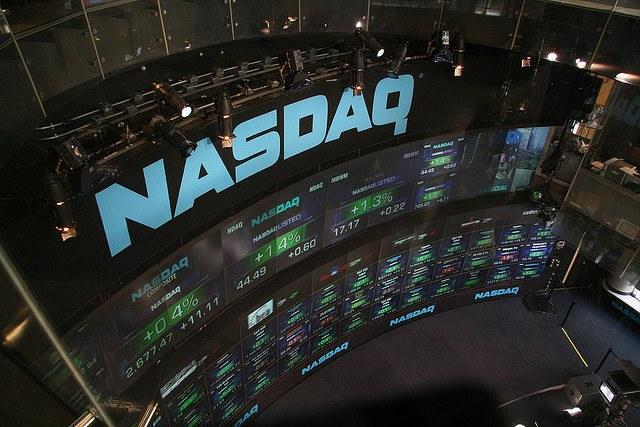

Last January, while protesters gathered outside of a shareholders meeting at Monsanto's St. Louis headquarters, another smaller, less vocal but just as impassioned discussion was taking place inside.
As protesters chanted slogans and rallied for attention in the parking lot of one of the world’s largest biotech companies, stockholders were quietly adding their own form of input regarding GMO technology: shareholder resolutions.
Investors had asked the company to file a report answering key questions about genetically modified organisms (GMOs). They also asked the company to stop opposing the labeling of GMO foods.
Although neither resolution was adopted, the shareholders' message was clear and their effect immediate. Within hours, news media around the world was reporting that Monsanto investors were calling for accountability. They weren’t just listening to the company’s financial report; they were signaling to the board – and to the world – that some of Monsanto’s smallest investors were speaking up.
And the board got it.
“There is a recognition that we need to do more,” said Monsanto CEO Hugh Grant after the meeting.
Education: At the core of shareholder advocacy
The underlying benefit of such moves, says Dale Wannen, president of Sustainvest Asset Management, is education. The small contingent, which included about 15,000 signatures from investors, nonprofit advocacy organizations, farmers and business owners, wasn’t just promoting a position. It was educating the board about what its smaller investors – and its burgeoning reputation – hinged their future on: the faith of consumers, even those who didn’t buy from Monsanto directly.
Shareholder advocacy, says Wannen, who advises clients on responsible investing options, also helps “educate the public who may not know otherwise about environmental [or] social issues.” So while shareholders were circulating resolutions for the board’s consideration, they were also letting those who were watching know about what the shareholders felt the real issues were.
Using the shareholder's voice to effect change
Having a voice in the company is also a valuable way to demonstrate an interest in its priorities and directions, says Sister Nora Nash, the director of corporate responsibility for the Sisters of St. Francis of Philadelphia. The 500-member-strong Catholic congregation is a member of the Interfaith Center for Corporate Responsibility (ICCR), which is well known for its advocacy on environmental and social issues.
“We [feel] that it is important to be able to have a voice in corporations," says Nash, who notes that the congregation invests in stocks both to support its retirement fund and as a tool for environmental and social advocacy.
“[In] order to show that we are being responsible, we have a voice in those corporations because if you own shares you really need to speak to the issues of the day,” Nash says. “We believe that it is part of our mission to … use our investments for both social as well as financial benefits.”
And they do speak to the “issues of the day” quite often. Nash and her associates are well known for their willingness to sit down with corporate leaders and politely advocate for change. Some of those changes are sweeping. Many turn out to benefit the company as well as the communities they affect.
Speaking for those who can't
At the top of their concerns are companies that have the power to affect the lives and livelihoods of the world’s poorest citizens.
“We actually believe that we have a responsibility to speak for those who cannot speak for themselves. Many of our sisters work in communities that are poor or communities that don’t have a voice, and we want those people to have a voice through us or through other shareholder folks,” Nash says.
Sometimes their meetings are with companies in which they have no financial investment. Last year, following the tragic Bangladesh factory fire, Nash and other members of the ICCR began reaching out to corporations to encourage them to use their financial clout to improve working conditions in Bangladesh.
“[We] have written to at least 80 of the largest corporations to make sure that they sign a document that guarantees some help for workers,” Nash says. By signing on to the accord, she says, companies know that “they are making a commitment to do something” to improve conditions at the factories in Bangladesh. The end result is a mechanism that supports better social justice and a stronger sense of corporate social responsibility.
Transparent governance and shareholder advocacy
Shelley Alpern, who serves as the director of social research and advocacy for CleanYield Asset Management, says transparency is often a major focus in corporate settings. CleanYield is an associate member of the ICCR, as well as several other social advocacy organizations.
“We’re usually asking companies to commit to being more transparent as a matter of policy,” says Alpern, rather than as a one-time event. An example would be the resolution submitted at the Monsanto shareholder meeting in January, which called for a report to shareholders “revealing potential material financial risks or operational impacts on the company related to these GMO issues.”
But resolutions calling for improved transparency can cover just about anything, from employment hiring practices to company attitudes about social issues. LBGT rights, Alpern notes, used to garner a low response when votes were cast in shareholder meetings. “And now we routinely get upwards of 30 percent and usually, very often in the forties,” of those who feel LBGT rights should be a fundamental part of corporate social responsibility.
Old strategy, new focus and new outcomes
Shareholder advocacy has had a say in social change for decades, and has played a role in some of the largest political transformations in history. It emerged with the efforts of Saul Alinsky to improve the business practices of Eastman Kodak, but its most notable impact was during the South Africa Apartheid, which was transformed by shareholders who refused invest in and contribute to discriminatory social and political practices.
Today, says Nash, the pressing social issues include human trafficking and child labor. The Sisters of St. Francis and the ICCR are passionate about these topics and use shareholder advocacy to educate companies about the indirect impact of their commerce both inside and outside of their supply chain.
“Some of them really like to work with us, because even though they may not do what we ask to do, they always indicate it’s a good learning experience and there are times when they will tell us yes, they need to address the issue,” Nash says.
And, they listen, she says, because “they know we’re credible.” They recognize that the faith-based organization has paid a visit to their offices because the Sisters are out to improve working conditions and to “improve the standards in which our goods are being made.” The corporations respect that effort.
Alpern says that, in some circumstances, shareholder advocacy has gained an even stronger footing in corporate change.
“It’s definitely picked up steam. … [You] can literally chart a significant growth of average support for shareholder resolutions.”
She attributes this to two things: “Shareholders are becoming more cognizant of the implications on corporate value of environmental and social and governance matters." And they are becoming more aware of influential proxy voting advisory firms, sometimes called institutional investors, that are hired to advise shareholders with specific concerns, like a company’s environmental or human rights records.
From stocks to mutual funds to community advocacy
Wannen of Sustainvest Asset Management notes that the concept of owning stock has changed over the years. In the last 20 or 30 years “people have moved from owning individual stock, which is what my father or my grandfather would have owned, into mutual funds. They have moved it into these actual products that hold the stock for them.” It isn’t uncommon, says Wannen, to find that people don’t actually know what is in their mutual funds.
Still, he says, he has clients who will ask if they can buy a limited number of stocks in a particular company, explaining that they are unhappy with what the company is doing, and they want to have a say. Even though Securities Exchange Commission regulations stipulate shareholders must own at least $2,000 of shares and hold those stocks for a year before they can submit a resolution, Wannen says buying stocks is one way people feel they have a voice.
But resolutions aren’t the only mechanism for change, says Nash: “[If] a company is willing to take the next step, we definitely prefer to dialogue. The resolution is a tool to get the corporation, I guess you might say, to pay attention.” But the true strength, she says, is the collective voice -- the momentum that comes from people, or a network of organizations expressing the desire for change, and the willingness to work with the companies to see that through.
Out of such efforts have come a number of recent landmark changes, such as Tyson Foods’ agreement last year to do away with gestation pens for pigs and increasing efforts by food manufactures to use only sustainably grown and harvested palm oil.
There have also been unusual but heartening stories of CEOs who, despite their companies’ resistance to change, have made efforts to listen to shareholders. The recent agreement of Duke Energy CEO Lynn Good to take a canoe trip down the polluted Dan River with environmentalists is one example that highlights a change that was forged through dialogue between the company and its shareholders.
“[We] know in the work that we do, we can enable the world to be just a little bit better than it is,” Nash says. “And there is always room for improvement.”
Edmond Meany passionately addressing Alaska-Yukon-Pacific Exposition stockholders and president, Seattle, Washington, September 19, 1908: Frank H. Nowell, 1864-1950/PD
NASDAQ image: Bfishadow
Despite Doubts, Fuel Cell Electric Vehicles Are Breaking Into the EV Market
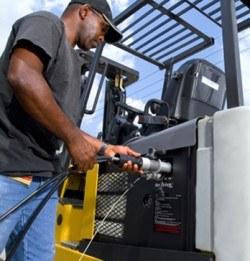

Fuel cells have a lot of catching up to do when it comes to beating out lithium-ion batteries for domination of the emerging electric vehicle market. "A lot" is an understatement. When you ask auto industry followers about the potential for fuel cell electric vehicles, you are likely to be met with rolled eyes and a repetition of the same old joke: "They say fuel cells are the next big thing, and they've been saying that for 30 years."
However, if you take a look at what's been going on in at least one specialty niche of the EV market, you can catch a glimpse of the possibility for fuel cells to win out, at least for some applications. That potential is illustrated by Plug Power and Ace Hardware, which have paired up to bring entire fleets of fuel cell electric vehicles into shipping and handling operations.
Fuel cell EVs for warehouses
Plug Power first came across Triple Pundit's radar in 2012. Though the auto industry's interest in fuel cell EVs was on the wane back then, companies like Plug Power recognized the attraction of fuel cell EVs for warehouse operations and other specialty markets.
In particular, the closed environment of a warehouse demands zero-emission forklifts and other specialty vehicles.
Seaports and other shipping operations are also increasingly looking toward zero-emission logistics, especially those located in urban areas looking to improve overall air quality.
To demonstrate the efficiency of fuel cell technology in commercial use, the Obama administration has recruited private sector partners to deploy fleets of fuel cell forklifts, as well as stationary fuel cells, for backup power.
As for the bottom-line advantages of fuel cells over batteries in shipping and logistics, back in 2012 CEO Andy Marsh summed them up quite nicely (break added for clarity, and here's that link again):
The main issue is productivity. It can take up to 15 to 20 minutes to replace a battery (which occurs every 6 hours or so). Fells cells run longer and can be refilled in just a few minutes.Furthermore, battery power declines during a shift, and over its life, slowing the vehicles in the process, while fuel cells can remain constant over their life. Finally, we eliminate the battery room, which can take up 6 to 7 percent of a large distribution facility.
Plug Power and Ace Hardware
Fast forward a few years, and Plug Power has grown a solid roster of customers for its GenDrive fuel cell technology.
The Ace Hardware order marks the first all-hydrogen fleet for Ace, consisting of class-2 and class-3 lift and reach trucks. This fleet was deployed at the company's just-finished 450,000 square-foot warehouse in Texas three months ago, along with an on-site hydrogen fueling station.
The preliminary results have already given Ace enough evidence to go forward with another deployment of GenDrive fuel cell electric vehicles. This one is slated for an even bigger warehouse under construction in Ohio, clocking in at 534,000 square feet.
Once the second fleet is up and running, Ace will lay claim to a total of 130 hydrogen fuel cell electric vehicles.
One thing worth noting here is that the confined area of operation and the on-site fueling station together relieve the technology of one major criticism: There is no public infrastructure for refueling hydrogen fuel cell EVs.
That still holds true for open-road vehicles, but you could have made a similar case against battery EVs just a few years ago. If all goes according to plan, the Obama administration's H2 USA initiative will help the fuel cell market catch up sooner rather than later.
Getting the hydrogen for your fuel cell forklift
As of this writing, the hydrogen fuel cell market is highly dependent on hydrogen sourced from fossil natural gas.
That opens a huge can of sustainability worms, but it also puts fuel cell EVs on the same footing as battery EVs that are charged from a grid mix that consists of fossil sources.
That point will soon be moot for the battery EV market, which is rapidly shedding its reliance on fossil fuel-sourced electricity.
The fuel cell market is also beginning to take strides in that direction. Hydrogen sourced from solar-powered water splitting is one example. Biogas is another potential route, including biogas sourced from wastewater treatment plants.
Image courtesy of Plug Power
Puerto Rican McDonalds Franchisees Claim HQ Hung Them Out to Dry
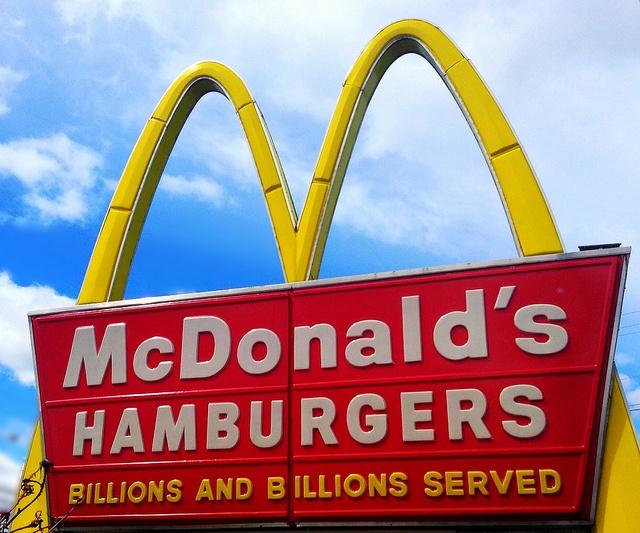

A group of McDonald’s franchise operators in Puerto Rico is alleging that the fast food giant violated federal law and a Federal Trade Commission (FTC) rule that regulates the behavior of franchisors.
According to the Puerto Rican franchisees (the Plaintiffs), McDonald’s first violated the Franchise Rule when it sold its Latin American franchises -- and, consequently, McDonald’s franchise rights in the Puerto Rican market -- to the Latin American company, Arcos Dorados, in 2007. Subsequent actions by Arcos Dorados in Puerto Rico have caused additional harm to the Plaintiffs, in further violation of federal law.
Plaintiffs allege the various harms and violations have occurred. Specifically, they claim that McDonald’s “cut off all ties with Puerto Rico operators” after the sale to AD, after which the new owners (Arcos Dorados) began downgrading services to the franchise owners, absent disclosure to the FTC and in violation of FTC Act 5 Section 5 (unfair competition) and the Franchise Rule. Plaintiffs further allege that AD is neglecting to conduct sufficient sales analyses before opening new McDonald’s locations, leading to areas with a glut of McDonald’s restaurants and the resultant supply-and-demand problems for Plaintiffs’ businesses.
More than McDonald’s, though, the real villain in this story is Arcos Dorados (AD), a McDonald’s franchising behemoth.
Spanish for “Golden Arches” (really), AD is the largest McDonald’s franchisee in the world, with more than 2,000 McDonald’s restaurants and exclusive rights to own, operate and franchise McDonald’s restaurants in Latin America and the Caribbean. The company has more than 90,000 employees, was recently named the fourth best company in Latin America and had sales of over $4 billion in 2013.
AD went public in 2011, after posting $3 billion in revenues and $106 million in profits the year before. As a result of the 2011 IPO, AD’s CEO, Woods Staton, become a billionaire. Importantly, as McDonald’s has encountered recent domestic difficulties, AD’s profits have continued to rise. Last quarter, AD reported sales up 10.6 percent for the quarter and 11.2 percent for 2013. The company’s success in Latin America is due in part to its actively marketing to lower income residents and its aggressive growth strategy.
In other words, the preexisting McDonald’s franchisees in Puerto Rico believe they were sold a bill of goods. The Plaintiffs expected that all Puerto Rican McDonald’s would maintain a certain standard of quality, thereby ensuring that their business would reap the benefits of the McDonald’s brand (whatever it is); and they expected that future McDonald’s restaurants would not open in close proximity to their original franchises, thereby syphoning off potential customers. According to their complaint, Plaintiffs’ (reasonable) expectations were not met in either case. If true, these allegations suggest questionable behavior on the part of Arcos Dorados, and of the type of competition that could typically be classified as “unfair.”
Importantly, this is not the first that AD or McDonald’s has heard from the Puerto Rican franchisees. In January 2007, several Puerto Rican franchisees brought a suit in Puerto Rican court against McDonald’s and certain subsidiaries which AD purchased, seeking, among other things, to prohibit AD from opening new restaurants within a three-mile radius of a franchisee’s restaurant. In September 2008, AD countersued, attempting to terminate the franchise agreements with these franchisees, and a trial commenced on Sept. 10, 2012. According to its most recent annual report, AD “does not anticipate that the trial hearings will conclude in the first semester of 2014.”
At the very least, the Puerto Rican franchisees have been singing a similar tune for years. Yet, it is hard to square these seemingly poor business decisions in Puerto Rico (why bother saturating the market and, in effect, competing with yourself?) with the otherwise successful conduct of AD elsewhere in Latin America. If the FTC buys what the Plaintiffs are trying to sell, then the Commission may order AD to change its behavior in Puerto Rico and/or pay potentially heavy fines. Both the FTC proceeding and the 2007 suit could impact the way McDonald’s -- and other multinational franchises -- compete in the Latin American market, and the outcomes deserve attention.
Image credit: Flickr/jeepersmedia